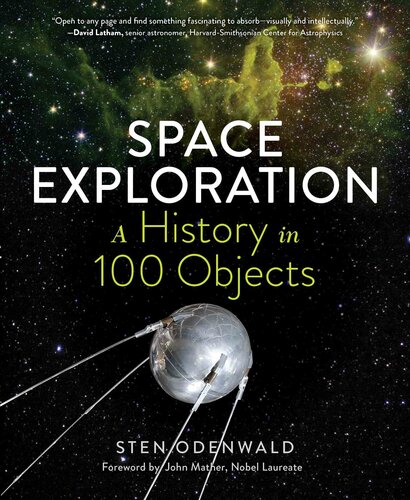
Space Exploration—A History in 100 Objects
کتاب های مرتبط
- اطلاعات
- نقد و بررسی
- دیدگاه کاربران
نقد و بررسی

Starred review from September 16, 2019
Astrophysicist Odenwald (Astrophysics in a Nutshell) surveys the history of space exploration in a captivating catalogue of artifacts and inventions. The 100 items depicted through colorful photos and concise explanations are “the workhorse tools and game-changing technologies” that have steered humanity to the stars, says Odenwald. They range from a 70,000-year-old etched stone artifact that bears the first known human drawing, and thus might be considered a “big bang of human ingenuity,” to the huge Event Horizon Telescope that, in 2019, generated the first image of a black hole. Elsewhere, Odenwald describes how meteorites delivered clues about the early solar system directly to the Earth, before advances in electronics and rocketry gave humanity the ability to leave the planet and begin exploring space. The earliest known lens, from 750 BCE, presaged the development of telescopes, from Galileo’s simple model to space-based leviathans like the Hubble and the exoplanet-hunting Kepler. Odenwald also includes everyday—yet, for space exploration, pivotal—items such as the slide rule, and novelties such as space food and Elon Musk’s orbiting Tesla Roadster. This resource is fun as well as informative, a lightweight encyclopedia of intriguing objects that will fascinate readers of any age.

November 1, 2019
Gr 9 Up-The author uses a wide range of unique items to trace discoveries and technology developments that marked crucial advances in understanding the world and the universe from 70,000 BCE to the present. Readers may see Sputnik on the cover and assume that all the items discussed are rockets and robots, but the artifacts include bronze medallions, petroglyphs, and medicine wheels, too. Readers will be amazed at the wide range of time periods and cultures represented by the featured examples. Photographs show the details of the astrolabes, star charts, and lenses, while the back matter includes a guide to the objects' current locations. The author's explanations of the significance of each piece in relation to astronomy and aerospace are also compelling celebrations of the contributions from around the world and throughout history. VERDICT A must for science departments and library collections.
Copyright 2019 School Library Journal, LLC Used with permission.

October 15, 2019
This engaging trek through the annals of human invention considers 100 physical artifacts that directly or indirectly advanced space exploration. Two-page entries with photos and accessible but satisfyingly technical essays are arranged chronologically, beginning in 70,000 BCE with the Blombos ochre artifact, a carving showing evidence of abstract reasoning. The first twelve entries fall within the BCE era; others wind through accumulating centuries (an algebra textbook, year 820; the slide rule, 1662; solar panels, 1839), and then dates speed up as breakthroughs hit the twentieth-century mark (the last two entries are the Tesla Roadster launched in 2018 and the 2019 sighting of a black hole via the Event Horizon Telescope). Coverage is international, for both ancient civilizations (Egyptian, Babylonian, Mayan, Anasazi) and modern nations (the U.S., Soviet Union, India, and China). A brief appended biography identifies author Odenwald, a NASA astrophysicist, as a "science popularizer." Whether read straight through or referenced by artifact, his collection of brief but enlightening entries is addictive and should appeal to a wide audience.(Reprinted with permission of Booklist, copyright 2019, American Library Association.)

























دیدگاه کاربران